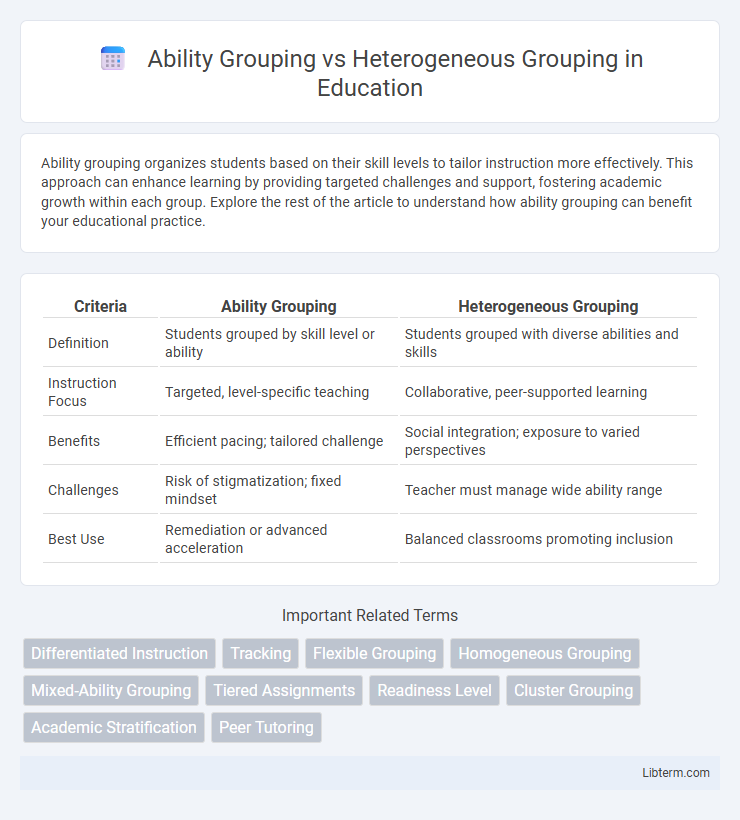Ability grouping organizes students based on their skill levels to tailor instruction more effectively. This approach can enhance learning by providing targeted challenges and support, fostering academic growth within each group. Explore the rest of the article to understand how ability grouping can benefit your educational practice.
Table of Comparison
| Criteria | Ability Grouping | Heterogeneous Grouping |
|---|---|---|
| Definition | Students grouped by skill level or ability | Students grouped with diverse abilities and skills |
| Instruction Focus | Targeted, level-specific teaching | Collaborative, peer-supported learning |
| Benefits | Efficient pacing; tailored challenge | Social integration; exposure to varied perspectives |
| Challenges | Risk of stigmatization; fixed mindset | Teacher must manage wide ability range |
| Best Use | Remediation or advanced acceleration | Balanced classrooms promoting inclusion |
Introduction to Ability Grouping and Heterogeneous Grouping
Ability grouping organizes students into classes or groups based on similar skill levels, enabling tailored instruction that targets specific learning needs. Heterogeneous grouping mixes students of varying abilities, fostering diverse interactions and collaborative learning that can enhance peer support and motivation. Each approach offers distinct strategies to optimize classroom engagement and educational outcomes according to student diversity.
Defining Ability Grouping: What Is It?
Ability grouping refers to the educational practice of organizing students into groups based on their shared skill levels or academic performance. This method aims to tailor instruction to specific learning needs, allowing teachers to target content and pace according to group abilities. Unlike heterogeneous grouping, which mixes diverse skill levels, ability grouping facilitates focused skill development and streamlined lesson planning within homogeneous groups.
Understanding Heterogeneous Grouping in Education
Heterogeneous grouping in education involves organizing students of varying abilities, backgrounds, and learning styles into the same group to promote diverse perspectives and collaborative learning. This approach fosters social skills, inclusivity, and peer support, which enhances critical thinking and problem-solving through exposure to multiple viewpoints. Research shows heterogeneous groups improve overall academic achievement by encouraging students to develop communication and teamwork skills essential for real-world success.
Historical Context and Educational Theories
Ability grouping emerged in the early 20th century, influenced by intelligence testing and the belief in innate differences in student capability, aligning with theories of differentiated instruction and the efficiency of tailored curriculum. Heterogeneous grouping gained prominence mid-century, rooted in progressive education ideals and social constructivism, emphasizing collaborative learning and social integration among diverse learners. Educational theorists like Vygotsky supported heterogeneous grouping for its potential to enhance cognitive development through peer interaction, contrasting with ability grouping's focus on individualized skill levels.
Academic Benefits of Ability Grouping
Ability grouping enhances academic outcomes by tailoring instruction to students' specific learning levels, allowing for targeted teaching strategies that address individual needs. Research indicates that students in ability groups often demonstrate higher achievement and accelerated mastery of skills due to focused curriculum pacing. This method also supports enrichment opportunities for advanced learners, promoting deeper understanding and academic growth.
Academic Benefits of Heterogeneous Grouping
Heterogeneous grouping fosters diverse academic benefits by promoting peer learning, enhancing critical thinking, and developing social skills across varied ability levels. Students in mixed-ability groups gain exposure to multiple perspectives, which encourages deeper understanding and collaborative problem-solving. Research shows heterogeneous grouping improves overall academic achievement and equity by supporting differentiated instruction tailored to individual learning needs.
Social and Emotional Impact on Students
Ability grouping often leads to improved self-esteem and motivation for high-achieving students but can cause social isolation and decreased confidence in lower-achieving peers. Heterogeneous grouping promotes empathy, collaboration, and diverse peer interactions, fostering stronger social skills and emotional resilience across all ability levels. Students in mixed-ability groups tend to develop better interpersonal relationships and experience less stigma compared to those in ability-segregated classrooms.
Equity and Inclusion Considerations
Ability grouping often risks reinforcing achievement gaps by segregating students based on perceived skill levels, which may limit access to diverse perspectives and inclusive learning environments. Heterogeneous grouping promotes equity by fostering collaboration among students with varied abilities, encouraging peer support and reducing stigmatization associated with high- or low-ability labels. Implementing inclusive teaching strategies within heterogeneous groups enhances engagement and addresses diverse learning needs, supporting equitable academic growth for all students.
Case Studies and Research Findings
Case studies reveal that ability grouping often enhances achievement for high-performing students but may widen achievement gaps for lower-performing peers. Research findings indicate heterogeneous grouping fosters collaborative skills and social development, boosting overall classroom engagement and critical thinking. Longitudinal studies highlight that mixed-ability groups contribute to sustained academic improvement while supporting diverse learner needs more effectively than homogeneous skill-based groups.
Best Practices and Recommendations for Educators
Effective ability grouping requires regular assessment and flexible groupings to address student growth and avoid fixed labels, promoting tailored instruction that meets diverse learning needs. Heterogeneous grouping fosters collaboration and social skills by mixing students of varying abilities while supporting peer learning and inclusive classroom environments. Educators should balance both methods, incorporating clear objectives, ongoing monitoring, and differentiated strategies to maximize student engagement and achievement.
Ability Grouping Infographic

 libterm.com
libterm.com